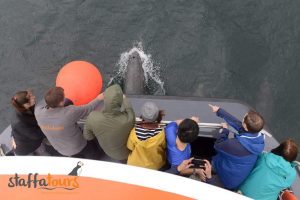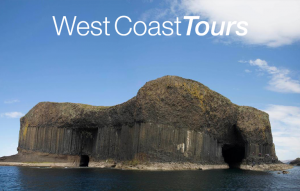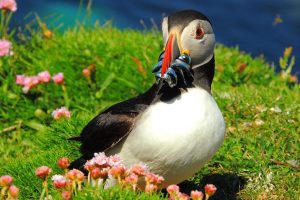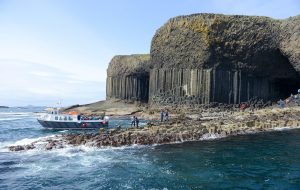Staffa & Fingals Cave Treshnish Wildlife Tour (Sails from August)
-
Departs:
Tobermory, Ardnamurchan
- 4 hours
£ 60
Staffa and Treshnish Isles Wildlife Tour from Fionnphort or Iona
-
Departs:
Iona, Fionnphort
- 6 hours
£ 85
During the warmer months, most visitors come to see the whales that migrate from the south to spend the summer feeding in the nutrient-rich Hebridean waters. The area is a hotspot for whale sightings during the summer and people come from all over the country and abroad for an unforgettable whale watching boat trip.

Minke Whales
Minke whales are the most common whales to visit and are often seen in deeper waters where tides meet and there are higher volumes of fish, but depending on the location can also be seen from shore although shore sightings are rare.
Minke whales are baleen whales and feed on shoals of small fish. When feeding, they encircle a shoal from below blowing out air bubbles as they go. This drives the fish closer and closer together until they form a tightly packed bait ball. The whales then rise up and swallow the fish in one giant mouthful. Minke whales are baleen whales and as they engulf mouthfuls of fish and water, plates filter out the water to be able to swallow their food.
Whales feeding on bait balls always attract seabirds, specifically Manx Shearwater, that are driven into a frenzy as they wheel overhead and dive in to catch some fish. Observing Manx Shearwaters diving into the water is an obvious indication to the possibility of a whale sighting. Together, the feeding whales and diving seabirds make a truly spectacular sight.
While whales aren’t difficult to spot, they are often heard before they’re seen, expelling air from their blowholes and as a result water which is on the body surface may be blown and has a rotten cabbage smell. Signs to watch out for are obviously when they break the surface, flat patches of water where they have just dived, splashes and irregular waves.
Orca
Orca or Killer Whales are one of the fastest swimming sea animals and are regular visitors to Scotland’s West Coast during spring and summer.
They can grow to between 5-8 metres and up to 5, 000 kg and have very distinctive colouring with large black dorsal fins and white undersides with a white eye patch.
Although the Hebridean Orca are few in number, they are travel widely, are always on the move and travel huge distances and because of this sightings are rare, but when we do spot them it is always an exhilarating experience.
Rarer Whale Sightings
Although sightings of Minke whales are the most common, there are occasional sightings of other whale species as they migrate from warmer, southern waters to feeding grounds around Iceland and Norway. These include Humpback, Fin, Pilot and Sperm whales with the occasional sightings of Northern Bottlenose and Sei whales.





